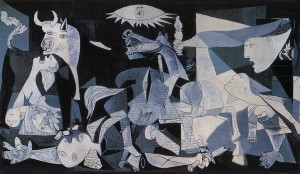Pablo Picasso
Spain, 1881-1973
Guernica, 1937
11′ 5″ x 25′ 6″
Oil on canvas
Museo Nacional Centro de Arte Reina Sofía Museum DE00050
Moved by the Nazis’ bombing the Basque town of Guernica, Pablo Picasso created Guernica as a political statement. In it he illustrates the malicious side of war and the harm that it causes to people through characters such as the decapitated man, the distressed horse, and the mother with a dead child. The bull located in the far left corner symbolizes destruction, while the distressed horse at the center represents the people of Guernica because appears to be screaming for help. Guernica contains only three colors: black, blue, and white. The color scheme, which causes the painting to feel like a photograph, increases the drama within the painting along with the well-defined lines. The mural-size of the painting, likened to a monument, adds to the message that Picasso is most likely trying to convey: the impact of war on innocent people.
Vena Cummings
